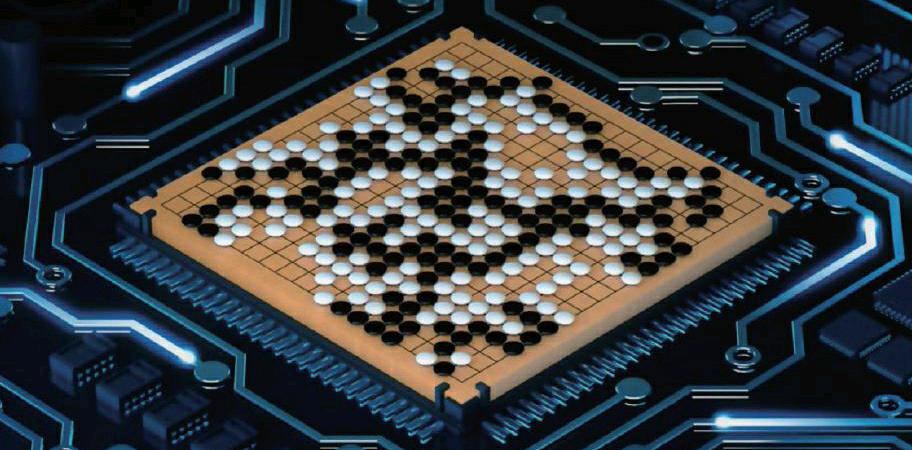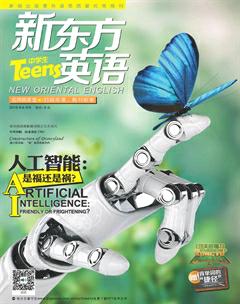何为人工智能?
今年3月,谷歌下属公司DeepMind开发的人工智能软件AlphaGo在围棋比赛中大胜世界围棋冠军李世石,在世界范围内引起了轩然大波。AlphaGo的胜利代表了人工智能飞跃式的进步,人们纷纷开始担忧机器人对人类产生威胁的时代即将到来……人工智能究竟是什么东西,居然可能会有超越人类的智慧?先随下文一起来了解一下吧!
If you touch a hot metal object, you will yank1) your hand away immediately. When this happens to you the first time, the sequence of events and the result (the burning of your hand) gets stored in your brain. This is what we call an experience. When you see a hot metal object next time, you will not touch it. You will use the knowledge of your previous experience and decide to not repeat it again.
This process of learning, comparing a previous experience, making a decision and acting upon it is the key to human intelligence. We can make more and more complicated decisions by learning from our past experiences.
Ever since machines were invented, scientists have dreamt of making them learn and perform intelligent tasks—like humans.
Artificial intelligence (AI) is a branch of science which is into2) making machines think like humans. These machines, or computers, can store large amounts of information and process them accurately and at an amazing speed. What they lack is an ability to learn and make "intelligent decisions".
What do we need to make an intelligent machine? A memory or a space where experiences or information can be stored, and a method of applying these experiences to new ones, comparing experiences to come to logical conclusions, like holding the hot object with a glove on. That would be an intelligent machine.
Take your iron3) for example. The electric iron understands that its temperature is beyond what is required and automatically switches itself off4). We could say that the electric iron is intelligent as it can react to a particular state (the iron being hot), make a decision based on it and switch itself off. However, since the iron has not learned this through experience, it is not a truly intelligent machine.
Scientists are creating new software programs which try to recreate the process of human learning in a computer, in an attempt to make them "think". These programs try to copy the functioning of the brain. One such program is called a neural5) network.
摸到发烫的金属物体,你会立马猛地抽回手来。当你第一次碰到这种情况时,整个事件的经过和结果(手被烫)便会被存入你的大脑,这就是我们所说的“经历”。当你下次看到发烫的金属物时,你就不会伸手去摸它了。你会运用先前的经历所带来的知识,决定不去重蹈覆辙。
这一“认识了解—对比过往经历—做出决策—付诸行动”的过程正是人类智能形成的关键。我们能够从以往的各种经历中汲取教训,做出愈加复杂的决策。
自从机器问世以来,科学家们就一直梦想着能让它们学习并开展智力活动——就像人类一样。
人工智能(简称AI)是一个科学分支,致力于制造可以像人类一样思考的机器。这些机器或计算机可以储存大量的信息,并能够以惊人的速度准确地对这些信息进行加工处理。它们所缺乏的是学习并做出“明智决定”的能力。
那制造一台智能机器都需要什么条件呢?一个可以存放经历或信息的存储器或者空间,以及一种可将这些经历应用到新环境的方法,即比较各种经历以得出合理结论(比如,戴上手套去拿高温物体)。满足这些条件的机器就是智能机器。
以电熨斗为例,电熨斗感知到自身温度超出需求时就会自动断电。我们可以说,电熨斗具有智能,因为它可以针对特定情况(熨斗过热)有所反应,并据此做出决定,自动断电。不过,由于电熨斗并不是通过自身经历学会的这项本领,所以它还算不上是真正的智能机器。
科学家们正在开发一些新的软件程序,试图让它们进行“思考”。这些程序力图在计算机上重建人类的学习过程,试图复制大脑的运转机制,其中一个程序叫做“神经网络”。
Our brain is composed of6) billions of densely packed cells called neurons. Each neuron is like a tiny individual switch in a net of billions of such neurons.
Whenever a particular piece of information, like someone's telephone number reaches your brain, it creates a pattern of on and off switches using these neurons.
Let's use an example to understand this phenomenon. We put up garlands7) of electric lights to decorate our houses during Diwali8). These lights create various patterns and designs, one switch creates a series of circles, another switch a pattern of flowers and so on.
A neural network is like these garlands of lights: A particular input creates a particular pattern. Each nerve cell or neuron in our brain acts like a light bulb. It creates a particular pattern on receiving an input.
When we memorize someone's telephone number, we actually create a pattern in our brain. And when we try to remember the same number, we simply try to recreate that pattern, unlike the lights which need to be switched on or off every time that pattern needs to be created.
A neural network is a copy of the brain's functioning inside a computer, using a software program. It can be taught to recognize patterns.
In fact, when it is trained, it can classify and identify patterns in a large amount of information. It can do all this at very high speeds and sometimes faster than humans.
This throws open innumerable possibilities. Imagine computers, which can look at the past weather and climate data, match them with current conditions and tell us where it is going to rain and how much.
我们的大脑由数亿个密密麻麻的细胞构成,这些细胞称为神经元。数亿个这样的神经元构成了一个神经元网络,每个神经元就像是网络上一个小小的独立开关。
每当一条特定的信息,比如某人的电话号码,进入你的大脑,大脑就会启动神经元,生成一种开关模式。
我们可以打个比方来理解这一现象。过排灯节时,我们都会用一串串彩灯来装点屋子。这些彩灯可以制造出不同的样式和图案,打开一个开关形成一系列圆圈,打开另一个开关变成花朵的图案等等。
神经网络就好比这些彩灯串:一条特定的输入信息会生成一个特定的模式。我们大脑里的每个神经细胞或者说神经元就像一个灯泡,收到一条输入信息就生成一种特定的模式。
我们在记一个人的电话号码时,实际上是在大脑里生成一种模式。当我们试图记起相同号码的时候,我们只需努力再现这种模式即可,不用像灯泡那样每次都要打开或关闭开关才能形成这种模式。
神经网络是在计算机内部对大脑功能的复制版,通过使用一个软件程序来实现。我们可以教它识别各种模式。
事实上,经过训练的神经网络可以从海量的信息里对各种模式进行归类和识别,而且完成这些任务的速度很快,有时甚至快过人类。
这将产生无限可能。试想一下:电脑可以参照以往的天气和气候数据,根据当前的气象条件进行匹配,然后告诉我们哪里会降雨、雨量多少。
In 1950, famous mathematician Alan Turing devised a method of testing a computer's intelligence. A person is kept inside a closed cell9) and asked to speak to a hidden human being and a computer.
The person, who is also called the interrogator10) (one who questions), does not have any clue about who is the human being and who the machine. His task is to find out which of the two candidates is the computer, and which is the human by asking them questions. If the interrogator is unable to decide within a certain time, the machine is considered intelligent.
1950年,著名数学家艾伦·图灵设计出一种测试计算机智能的方法。一个人被关进一个封闭的房间,并被要求去跟隐藏的一个人和一台计算机对话。
这个人,又称讯问者(提问的人),完全不知道对方谁是人,谁是计算机。他的任务是通过对这两者提问,辨出两者哪个是计算机,哪个是人。如果讯问者在一定时间内无法做出判定,那么就可认为那台计算机具有智能。

